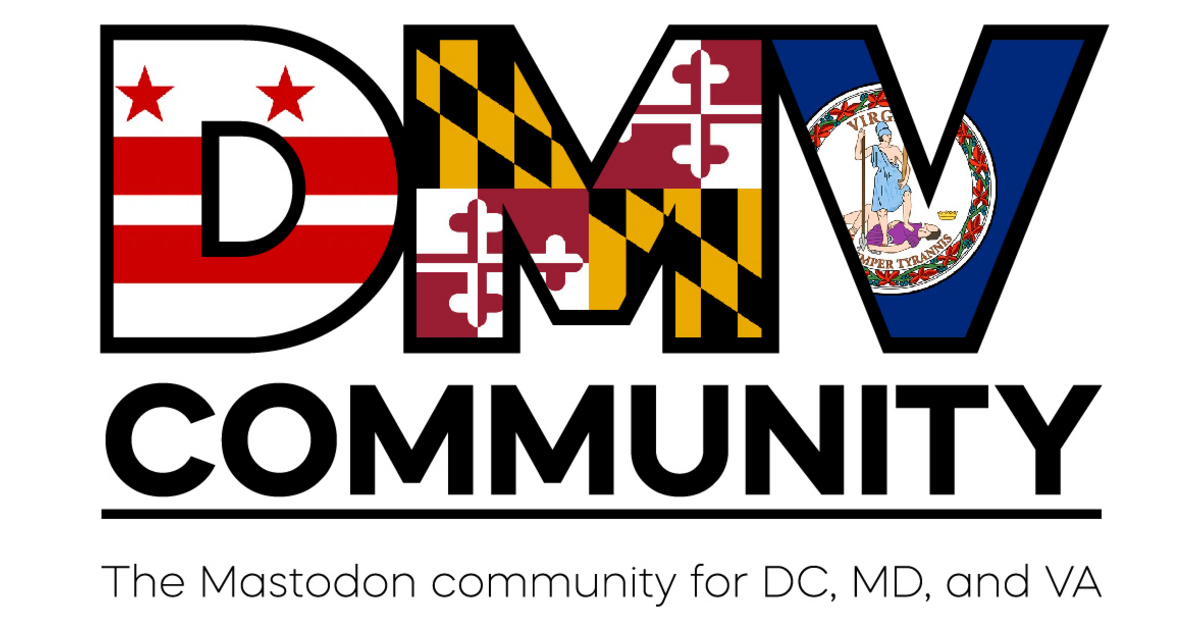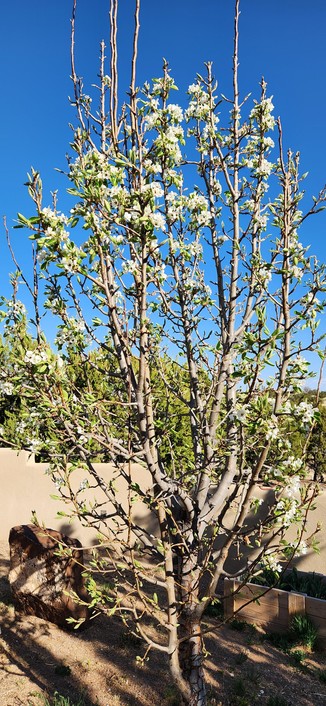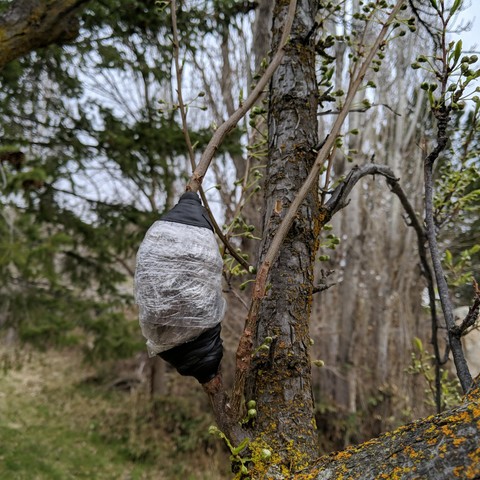Should see some open bloom on the Gravenstein apples this coming week. At the 'late pink' stage.
Recent searches
Search options
#fruittrees
The Brooks plum, Comice pear, and Bosc pear will bloom this year. They were planted last spring. Not sure if I can keep any fruit on the pears, but the plum should be able to support a few fruit.
I got out yesterday after work and wrapped my fruit trees and currant bush, but I forgot about my raspberry and gooseberry bushes (luckily it didn't end up freezing last night). I don't have any way to get any sort of cover over them, and it is supposed to be in the 20sF early tomorrow, Tuesday morning.
I'm not what sure do. I guess I could set an alarm for some time in the middle of the night to check the temperature, then if it is trending below 30°F, run the hose spray over the bushes, hopefully making ice that would coat their leaves at 32°F rather than dipping below that.
Another option would be to put one of my temperature sensors out near the berry bushes to see what kind of microclimate I've got there, and then if that drops, protect them with the water. Those bushes are generally more protected by structures and the lay of the land than everything is out front. Maybe that area won't hit the freezing mark?
This is #Kansas, so I'm used to losing fruit crops because the weather in April didn't cooperate.
This dip tonight means we likely won't get any peaches or pears from local trees unless farmers go to extremes to try to keep those from freezing. I don't remember having Kansas peaches more than one time over the last 10 years because of April freezes.
Peaches seem to be the most sensitive, which is part of why I've never planted a peach tree.
An air layering attempt on the old Santa Rosa plum. Harvested the sphagnum moss from the rock seen in the background. Now we wait.
Yes, I could just buy another Santa Rosa plum but then it's not THIS plum. This also ignores the fact that the chances of getting the same plum is near zero because "looks like" is more important than "actually is" in the buy a plant world these days.
The Comice pear, the oldest Gravenstein apple, an early blooming peach grown from seed, and the Harcot Apricot. I saw quite a few apricots blooming when I was out and about today. The Japanese type plum here is a couple of warm days away from starting to bloom and it doesn't look like it's died much more. It's more than 50 years old.
Spring and the apricot trees-
#FruitTrees #Spring #Flowers #Fruit
I was feeling under the weather today so I took a nap instead of a walk. When I got home from work, our thundercloud #plum tree greeted me the best way it could.
Here's the first blossom of the season!
Tomorrow and the days that follow will yield more, but this was the first one (at least, the first near the ground) that opened up to say hi.
Thankful for small joys like this.
Ask Me Anything LIVE Q&A: Episode 05 | The Millennial Gardener https://www.diningandcooking.com/1914423/ask-me-anything-live-qa-episode-05-the-millennial-gardener/ #DIY #EdibleLandscaping #FoodForest #FruitTree #FruitTrees #garden #GardenHacks #GardenTips #Gardening #GardeningHacks #GardeningTips #GardeningTipsAndTricks #grow #growing #HowTo #live #livestream #livestreaming #MillennialGardener #organic #OrganicGardening #q&a #QuestionAndAnswer #RaisedBed #TheMillennialGardener #VegetableGarden #VegetableGardenVideos #VegetableGardening #VegetableGardeningVideos
@Laplantgenetics Can confirm here in the #SanFranciscoHellscape - the apricot tree and plum tree seem to agree it is spring #FruitTrees #BloomScrolling
Make your own apple trees—Online grafting classes from Seed Savers Exchange (US)
SSE sends you the materials you need (rootstock, grafting knife, etc.), classes meet online
https://seedsavers.org/events/apple-grafting/
Grafting is a great skill to have. You have many more options for varieties, and it saves a lot of money versus nursery-grown trees. I graft 20-30 fruit trees every spring to distribute in my community.
A fellow fruit trees pruning apprenticeship student, uses pruning saw on a dwarf apple tree. #HandsOnLearning at #WellandCommunityOrchard. The apprenticeship program is funded by #LifecyclesProject #nonprofit #FoodSecurity organization.
Here is River. They are the #WellandCommunityOrchard coordinator/educator for the 2025 Winter #FruitTrees #pruning #apprenticeship program - funded by local #FoodSecurity #nonprofit organization, #LifecyclesProject. Today was day 1 of the hands on apprenticeship learning program which runs for just over a month.
Here, River is giving a pruning saw demo on a dwarf apple tree.
I applied & was accepted into the new LifeCycles #FruitTrees #internship program. I start my first sessions in early January - shortly after returning from adaptive snow sports program on Mt. Washington. I'll be doing hands on learning over a period of 8 weeks; minimum of one session per week. Happy about growing my fruit trees practical knowledge I love learning more about #FoodSecurity elements.
I am the only disabled applicant who was accepted into the internship program
Last task of day. Uploaded my community event coverage vid
Please enjoy my little musical #video #slideshow of our 2024 #LifecyclesProject #CommunitySharing Day!
Julia is our midterm executive director & she's been doing a fantastic job.
Meet Julia:
Julia McDougall
Julia (she/her) is passionate about environmentalism and community engagement. Raised in Kamloops, British Columbia on Tk'emlups te Secwepemc territory, Julia spent her childhood hiking with dogs, canoeing through local lakes and rivers, and photographing the wildlife around her. With a camera and backpack in hand, Julia has travelled to six of the world's seven continents to learn as much as she can about different cultures and their connections to nature. Julia completed her undergraduate degree at the University of Guelph in Animal Biology and later pursued a Master's degree in Conservation Research at Oxford Brookes University. She has conducted research on mountain gorillas in Uganda and black bears in Canada, which has shown her the importance of community dedication to local conservation issues. The links between positive environmental health and public engagement are clear, and have paved the way to her connection with Lifecycles Project Society. On her days off, you can often find Julia surfing in Tofino, hiking with her pup, or kayaking around the coast of Vancouver Island.
Ella is a super rad person
Meet, Ella Swan.
Ella (they/them) is enthusiastic about increasing food security and reducing food waste. Raised to value local food systems, they have been working and volunteering for organizations related to sustainable agriculture and ecosystem health since their early teens. Their educational background is in Gender Studies, Environmental Studies and Restoration of Natural Systems. For Ella, the links between healthy food, healthy people and healthy ecosystems are clear. With practical experience in environmental restoration, farming and volunteer management, they are looking forward to supporting the administrative side of the Fruit Tree Project as well as joining in on fruit picks when opportunities arise. Ella is also passionate about art, and has a textile art practice. This is a way to (literally) weave together arts and environmentalism with their focus on reused materials, sheep to yarn explorations and natural dying. Ella is a settler of Scottish and English descent, and has been an uninvited guest on W̱SÁNEĆ and lək̓ʷəŋən territories for the past 9 years. They were born and raised on the territories of the Ktunaxa and Secwépemc peoples.



















